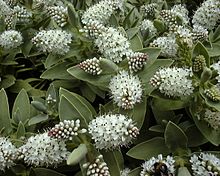
Veronica sect. Hebe is a group of plants within the genus Veronica, native New Zealand, Rapa in French Polynesia, the Falkland Islands and South America. It was formerly treated as the separate genus Hebe. It includes about 90 species. Almost all species occur in New Zealand, apart from Veronica rapensis and Veronica salicifolia, found in South America. The section and former genus is named after the Greek goddess of youth, Hebe. Informally, species in the section may be called shrubby veronicas or hebes.
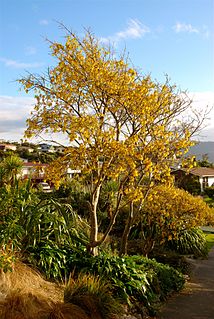
Sophora microphylla, common name kōwhai, is a species of flowering plant in the family Fabaceae, native to New Zealand. Growing to 8 m (26 ft) tall and broad, it is an evergreen shrub or small tree. Each leaf is 10 cm (4 in) long with up to 40 pairs of shiny oval leaflets. In early spring it produces many racemes of pea-like yellow flowers.

Lavandula stoechas, the Spanish lavender or topped lavender (U.S.) or French lavender (U.K.), is a species of flowering plant in the family Lamiaceae, occurring natively in several Mediterranean countries, including France, Spain, Portugal, Italy and Greece.

Erica vagans, the Cornish heath or wandering heath, is a species of flowering plant in the family Ericaceae, native to Ireland, Cornwall, western France and Spain. It is a vigorous, spreading, evergreen heather reaching 75 cm (30 in) tall and wide, with pink flowers borne in racemes 14 cm (6 in) long in summer and autumn. The Latin specific epithet vagans literally means "wandering"; in this context it means "widely distributed".

Vinca major, with the common names bigleaf periwinkle, large periwinkle, greater periwinkle and blue periwinkle, is a species of flowering plant in the family Apocynaceae, native to the western Mediterranean. Growing to 25 cm (10 in) tall and spreading indefinitely, it is an evergreen perennial, frequently used in cultivation as groundcover.

Jasminum polyanthum, the many-flowered jasmine or pink jasmine, is a species of flowering plant in the olive family Oleaceae, native to China and Myanmar. A strong evergreen twining climber, it is especially noted for its abundant, highly fragrant pink to white flowers.

Malva trimestris, common names annual mallow, rose mallow, royal mallow, regal mallow, and common annual tree mallow is a species of flowering plant native to the Mediterranean region.

Passiflora alata, the winged-stem passion flower, is a species of flowering plant. It is an evergreen vine, growing to 6 m (20 ft) or more, which bears an edible type of passion fruit. It is native to the Amazon, from Peru to eastern Brazil.
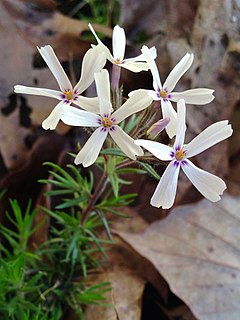
Phlox subulata the creeping phlox, moss phlox, moss pink or mountain phlox, is a species of flowering plant in the family Polemoniaceae, native to eastern and central USA, and widely cultivated.

Plumbago auriculata, the cape leadwort, blue plumbago or Cape plumbago, is a species of flowering plant in the family Plumbaginaceae, native to South Africa.

Gypsophila repens, the alpine gypsophila or creeping baby's breath, is a species of flowering plant in the family Caryophyllaceae, native to the mountains of central and southern Europe, where it grows on dry, chalky slopes. The Latin name literally means "creeping chalk-lover". It is a prostrate, mat-forming herbaceous perennial, growing around 20 cm (8 in) tall by 30–50 cm (12–20 in) wide. For much of the summer it bears masses of star-shaped flowers which may be white, lilac or light purple, in loose panicles.

Salvia patens, the gentian sage or spreading sage, is a species of flowering plant in the sage family Lamiaceae that is native to a wide area of central Mexico. This herbaceous perennial was introduced into horticulture in 1838 and popularized a hundred years later by the Irish gardener and botanist William Robinson (1838-1935).

Veronica nivea, the milfoil speedwell or snow speedwell, is a flowering plant species of the family Plantaginaceae, endemic to south-eastern Australia. It is sometimes included in the genus Parahebe or Derwentia.
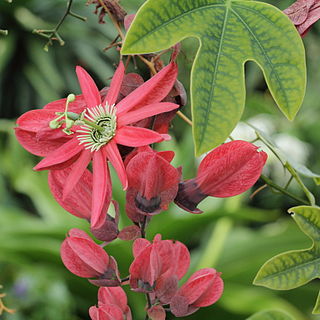
Passiflora racemosa, the red passion flower, is a species of flowering plant in the family Passifloraceae, native to Brazil. It is an evergreen climber growing to 5 m (16 ft), with simple or 3-lobed leaves to 10 cm (4 in) long, and vivid red flowers borne in summer. The flowers are 12 cm (5 in) in diameter, with purple and white coronas. They are followed by oblong green fruits.

Hebe pimeleoides is a flowering plant of the family Plantaginaceae. It is endemic to the dry mountains of Marlborough and Canterbury, in South Island of New Zealand. It is a low-growing, evergreen shrub, reaching 60 cm in height, with grey-green, spear-shaped leaves that are 7–10 mm long. Flowers are pale lilac.

Hebe recurva is a flowering plant of the family Plantaginaceae, which is endemic to the north-west area of Nelson on the South Island of New Zealand. It is an evergreen shrub, reaching 60 cm (24 in) in height, with gray, spear-shaped leaves that are 2–4 cm long. Flowers are white.

Hebe salicifolia, the koromiko, or willow-leaf hebe, is a flowering plant in the family Plantaginaceae, which is found throughout the South Island of New Zealand and in Chile. It is a large, evergreen shrub, reaching 2 m in height, with light green, spear-shaped leaves that are up to 12 cm long, and flowers that are white or pale lilac.

Agave parviflora is a species of succulent perennial flowering plant in the asparagus family, known by the common names Santa Cruz striped agave, smallflower century plant, and small-flower agave. It is native to Arizona in the United States and Sonora in Mexico.

Veronica austriaca, the broadleaf speedwell, large speedwell, Austrian speedwell, or saw-leaved speedwell, is a species of flowering plant in the plantain family Plantaginaceae, native to northern temperate Europe. Growing to 90 cm (35 in) tall by 60 cm (24 in) broad, it is a mound-forming herbaceous perennial, with deeply toothed leaves and erect spikes of bright blue flowers throughout summer.
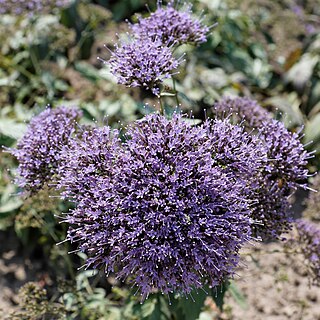
Trachelium caeruleum, common name blue throatwort, is a species of flowering plant in the family Campanulaceae native to the Mediterranean, where its native range includes Algeria, Morocco, Portugal, Spain, and Sicily. It has also become naturalized in a few areas, including New Zealand, the Azores, and parts of mainland Europe.
